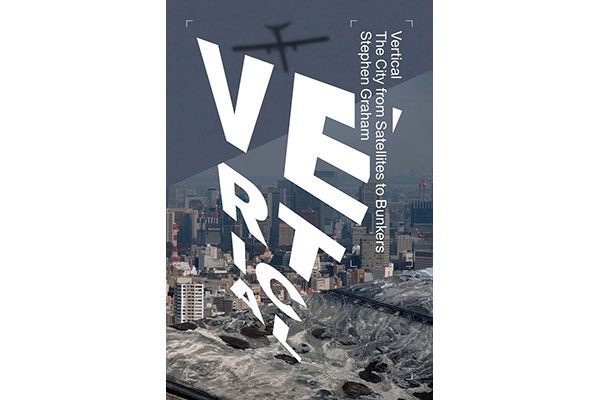
We popularly tend to think of cities horizontally—as entities that blanket the terrain. This perception has been fostered by the bird’s-eye-view-of-the-world bias we’ve been bombarded with to over the course of our lives: one that continues to be promoted by all the device-based mapping applications we use on a daily basis. Are there implications to this limited way of seeing the world? Is the centuries old practice of ignoring the vertical dimension still valid in our contemporary urbanized society? These are the fundamental questions powerfully addressed in Stephen Graham’s most recent book Vertical: The City from Satellites to Bunkers.
Opening with the Oxford English Dictionary’s definition of “vertical”, Graham’s wonderfully dazzling cross-sectional tour puts forth a powerful argument as to why our conventional ‘flat’ reading of the world needs to be re-calibrated to meaningfully engage the vertically layered reality of society. He does this by literally delaminating and critically examining wide-ranging themes intricately related to urbanism, across a vertical axis: necessarily slicing through a diversity of disciplines, in order to do so.
In keeping with the motivations of the book, Vertical is divided into two broad Parts, hierarchically subdivided into vertical layers that address a specific “structure, site or cultural world”. Part One: Above, is separated into—Satellite: Enigmatic Presence, Bomber: Death from Above, Drone: Robot Imperium, Helicopter: Direct Arrival, Favela: Tenuous City, Elevator/Lift: Going Up, Skyscraper: Vanity and Violence, Housing: Luxified Skies, Skywalk/Skytrain/Skydeck: Multilevel Cities and Air: Lethal Domes. Continuing this vertical decent, Part Two: Below is split into Ground: Making Geology, Basement/Cellar: Urban Undergrounds, Sewer: Sociology and Shit, Bunker/Tunnel: Subsurface Sanctuaries, and Mine: Extractive Imperialism on the Deep Frontier. These are bookended by an excellent Introduction that sets the foundation for book in describing the history and limitations of geopolitics as a ‘flat discourse,’ as well as an equally cogent Afterward that sums up the journey.
Given the sheer quantity of chapters, is easy to imagine Vertical as a thick tome, as complex to read as its subject. In reality, however, it’s a wonderfully dense yet extremely accessible (and addictive!) 400 page whirlwind of information, set within a compact 8” x 10” frame. No stone is seemingly left unturned and the close-packed content is supplemented by an incredible array of footnotes at the bottom of each pages, for ease of reference. One cannot understate the significance of this simple layout decision by the publishers. Given the transdisciplinary nature of Graham’s endeavour, readers can fluidly refer to and research the strong footnote content. I did so constantly and created an extensive folder of excellent online references, over and above the wide array of new books and authors I was introduced to across relevant disciplines.
Given the density of the content, I would normally avoid summarizing the content of the book beyond the above. However, in the spirit of doing the relevance and importance book even a little justice, allow me to give extremely brief summaries of each chapter just to whet the palette:
- Satellite: Enigmatic Presence – speaks to satellites as unscrutinized phenomena worth examining critically given their intimate relationship to the public realm gazing from above, and the fact that overtly shape our view of world (i.e. via Google Earth, etc.) as well as its design (i.e. The ‘Palm Islands’ developments in Dubai).
- Bomber: Death from Above – looks at the neglected links between aerial bombing and ground levels effects (casualties, etc.) as well as urban planning.
- Drone: Robot Imperium – focuses on the rise of drone use for military uses and otherwise, their limitations in terms of ways of seeing, as well as their connection to surveillance and racial, ethnic, and geographic profiling.
- Helicopter: Direct Arrival – describes the history of helicopters in the urban imagination, its uses in military and local policing, as well as the urban elite to by-pass exposure to the city.
- Favela: Tenuous City – highlights informal settlements and vertical slums, their history, and current transformations. Also touched upon are architectural speculations on mega-structure favelas.
- Elevator/Lift: Going Up – calls attention to the importance of elevators to the modern vertical city and the lack of critical discourse around it. Further connections are made to elevators, social inequality and vertical isolation.
- Skyscraper: Vanity and Violence – underlines the symbolism and politics of the skyscraper, their roles in the contemporary context of urban/national, their growing exclusivity and as objects of vanity.
- Housing: Luxified Skies – emphasizes the fallacy of vertical densification as an economic imperative. Critical to this chapter is a brief history of social housing policy and the stigma against vertical social housing. It stresses the process of elites “taking over the skies,” looking specifically at its effects in Vancouver, New York and London.
- Skywalk/Skytrain/Skydeck: Multilevel Cities – features a brief history of multi-level cities and their implementations, specifically in the form of internalized downtowns and central business districts. Also included is a discussion of elevated walkways, skytrains, sky parks, etc and their connection to social segregation.
- Air: Lethal Domes – singles out the politics of urban air and its relationship to social inequality. Furthermore, this chapter discusses urban heat island, manufactured air (i.e. air conditioning), its effects on people and the environment, as well as an interesting section on the manipulation of air as a weapon.
- Ground: Making Geology – describes “manufactured ground”—human-made geology born the vertical accumulation of urban material, as well as land reclamation and terraforming.
- Basement/Cellar: Urban Undergrounds – looks at urban basements as luxury excavations for the urban elite, using London as a case study. It also points out the mythology of subterranean spaces as locations of disease, poverty, disease and the lower class.
- Sewer: Sociology and Shit – underlines a brief history of the London and Paris sewer systems, the implications of hiding the system in the modern city, and connections of sexism and social stratification.
- Bunker/Tunnel: Subsurface Sanctuaries – put a spotlight on the creation of underground bunkers by the military to avoid vertical surveillance (I.e. From drones and satellites) and the use of tunnels as border crossings for the urban poor, tourism and urban exploration
- Mine: Extractive Imperialism on the Deep Frontier – describes that economics of resource extraction, the relationship between skyscrapers, mines and elevators, as well as the social and environmental impacts of mining practices (with a focus on gold).
Needless to say, Graham’s gaze seemingly leaves no stone left unturned: critically examining a vast panorama of critical urban issues rarely discussed in a meaningful way. This being the case, I do not hesitate to offer Vertical: The City from Satellites to Bunkers as one of the most important books on cities of the recent past. It is a must-read for anybody and everybody who is involved in city making—architects, urban planners, landscape architects, politicians, geographers, urbanists of any kind—as a necessary remedy to our lopsided survey of the modern city.
***
For more information on Vertical: The City from Satellites to Bunkers, visit the Verso website.
**
Erick Villagomez is one of the Editor-in-Chief at Spacing Vancouver. He is also an educator, independent researcher and designer with personal and professional interests in the urban landscapes. His private practice – Metis Design|Build – is an innovative practice dedicated to a collaborative and ecologically responsible approach to the design and construction of places. You can see more of his artwork on his Visual Thoughts Tumblr and follow him on his instagram account: @e_vill1.




